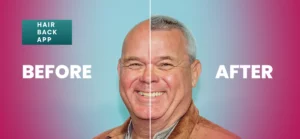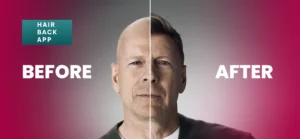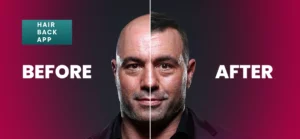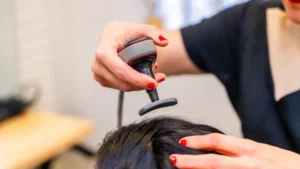Female pattern baldness, also known as androgenetic alopecia, is a prevalent condition that affects a significant portion of the female population. This form of hair loss can lead to thinning hair, loss of volume, and increased emotional distress, especially in a society where full, healthy hair is often seen as a key marker of beauty.
Unlike male pattern baldness, which often leads to a receding hairline or bald patches on the crown, female pattern baldness manifests more subtly, often as a thinning or widening of the part.
In this comprehensive guide, we will explore the causes, symptoms, treatments, and coping strategies for female pattern baldness, providing valuable insights for women affected by this condition.
Additionally, we will cover the evolving landscape of hair restoration treatments, including options like vegan hair transplants, hormones, and more.
What Is Female Pattern Baldness?
Female pattern baldness is the most common type of hair loss in women, affecting approximately one-third of women by the age of 50. It is a genetically predisposed condition that causes progressive thinning of hair, predominantly at the crown and top of the head, although the hairline typically remains intact.
Unlike men, who experience hair loss in specific patterns (such as receding hairlines or bald patches), female pattern baldness generally involves diffuse thinning, which can make it less noticeable in the early stages.
Hair loss in women can be particularly distressing because it tends to occur gradually and can be mistaken for normal aging or temporary shedding. However, over time, it may become more evident and lead to noticeable changes in hair density and overall appearance.

The Causes of Female Pattern Baldness
Female pattern baldness is primarily caused by a combination of genetic, hormonal, and environmental factors. Understanding these causes is crucial for developing effective treatment plans and preventing further hair loss.
1. Genetics
Genetics is the most significant factor influencing whether a woman will develop female pattern baldness. If there is a family history of hair loss, particularly among the mother’s or father’s side, women are more likely to experience thinning hair at some point in their lives. The exact genetic mechanisms are still being studied, but inherited traits from either parent can increase susceptibility.
2. Hormonal Changes
Hormonal fluctuations play a significant role in the development of female pattern baldness. These fluctuations can occur during various life stages, including:
- Pregnancy: During pregnancy, women experience a surge in estrogen, which can temporarily prevent hair shedding and make hair appear thicker. However, after childbirth, estrogen levels drop, leading to hair shedding, which can exacerbate existing thinning.
- Menopause: As women approach menopause, estrogen levels decline while androgen hormones (like testosterone) become more dominant. These hormonal shifts can lead to hair thinning, as androgens shrink hair follicles and shorten the hair growth cycle.
- Polycystic Ovary Syndrome (PCOS): Women with PCOS often produce excess male hormones (androgens), which can contribute to hair loss and thinning. Addressing the underlying hormonal imbalance is key to managing hair thinning in such cases.
3. Age
As women age, the hair growth cycle naturally slows, and hair follicles begin to shrink. The result is thinner hair, reduced volume, and increased shedding. The progression of hair loss is more noticeable as women get older, particularly around menopause, when hormonal changes accelerate thinning.
4. Nutritional Deficiencies
Hair loss can be exacerbated by a lack of essential nutrients, such as iron, zinc, biotin, and vitamin D. Women who follow restrictive diets, have poor eating habits, or suffer from conditions like anemia are at a higher risk of developing hair loss. Ensuring proper nutrition can help improve hair health and prevent further thinning.
5. Stress
Chronic stress can trigger telogen effluvium, a type of temporary hair loss caused by emotional or physical stressors. While telogen effluvium typically resolves once the stressor is removed, it can worsen the progression of female pattern baldness in women who are genetically predisposed to hair loss.
6. Medications and Medical Conditions
Certain medications, such as those used to treat high blood pressure, depression, or arthritis, can contribute to hair thinning. Medical conditions like thyroid disorders, autoimmune diseases, and anemia can also affect hair growth.
Symptoms of Female Pattern Baldness
The symptoms of female pattern baldness often develop gradually, making it difficult to recognize in its early stages. Common signs include:
1. Thinning Hair on the Crown
The most noticeable sign of female pattern baldness is thinning at the crown and top of the scalp. Unlike men, who often lose hair in the form of a receding hairline, women typically experience diffuse thinning throughout the scalp, with the crown being the most affected area.
2. Widening of the Part
A wider part can be one of the first signs of thinning. As the hair thins out, the part in the hair may appear larger or more noticeable, particularly when styled in certain ways.
3. Increased Shedding
Excessive hair shedding is another key symptom. If you notice more hair in your comb or brush than usual, or find hair on your pillow, it could indicate that you are shedding more than is typical.
4. Loss of Volume
Over time, thinning hair may result in a loss of volume, making your hair appear less dense. While this may be subtle at first, it can become more noticeable when wearing your hair down or in a style that exposes the scalp.
How Is Female Pattern Baldness Diagnosed?
Diagnosing female pattern baldness typically involves a combination of physical examination, medical history review, and diagnostic tests. The process may include:
- Physical Exam: A physical examination of the scalp and hair can help assess the pattern and severity of hair loss.
- Medical History: A thorough medical history, including information about family history, health conditions, and medications, will help the doctor understand potential underlying causes.
- Blood Tests: Blood tests may be ordered to check for underlying conditions such as thyroid disease, anemia, or hormonal imbalances.
- Scalp Biopsy: In some cases, a scalp biopsy may be necessary to confirm the diagnosis and rule out other types of hair loss.
Treatment Options for Female Pattern Baldness
Although there is no cure for female pattern baldness, there are several treatment options available to slow the progression and promote hair growth. These treatments range from topical solutions to surgical interventions.
1. Minoxidil (Rogaine)
Minoxidil is an FDA-approved topical medication for treating female pattern baldness. It works by stimulating hair follicles and promoting hair growth. When applied directly to the scalp, it has been shown to help slow hair loss and even encourage new hair growth in some women. Side effects include scalp irritation, so it is important to use the product as directed.
2. Anti-Androgens (Spironolactone)
Spironolactone is an oral medication that works by blocking the effects of androgens (male hormones) on hair follicles. This medication is often prescribed to women with hormonal imbalances that contribute to hair thinning. Side effects may include dizziness and menstrual irregularities.
3. Hair Transplants
For women with advanced hair loss, hair transplant surgery may be an option. This involves removing healthy hair follicles from areas of the scalp with strong hair growth and transplanting them to areas with thinning hair. Two popular hair transplant techniques are:
- Direct Hair Implantation (DHI): This advanced method involves extracting individual hair follicles and implanting them directly into the scalp. It is known for minimal scarring and faster recovery times.
- Vegan Hair Transplant: Some patients prefer vegan options for ethical reasons. Vegan hair transplant procedures use plant-based or synthetic alternatives to promote hair growth, offering a more ethical alternative to traditional methods.
Hair transplants can be highly effective, but it is important to note that success depends on factors like age, hair type, and the extent of hair loss.
4. Platelet-Rich Plasma (PRP) Therapy
PRP therapy involves using a patient’s blood, processing it to concentrate the platelets, and injecting it into the scalp. These platelets contain growth factors that can stimulate hair follicles and promote hair growth. PRP therapy is gaining popularity as a non-surgical treatment for hair loss.
5. Laser Therapy
Low-level laser therapy (LLLT) uses red light to stimulate hair follicles and improve blood circulation in the scalp. This treatment can be performed in a clinic or at home using FDA-approved devices like laser combs, helmets, or caps.
Hair Transplant Considerations: Hormones, Age, and Failures
When considering hair transplant options, it is essential to factor in various considerations, including hormones, age, and potential failures.
1. Hormones and Hair Transplants
For women with hormonal imbalances, such as those seen in polycystic ovary syndrome (PCOS), hair transplant outcomes may vary. Hormones play a significant role in hair growth, and ongoing hormonal treatment may be necessary to ensure the transplant’s success. Additionally, hormone fluctuations during menopause can also impact transplant outcomes, as the hormonal environment can affect hair follicle health.
2. Hair Transplant and Age
Age can influence the success of hair transplants. Women over the age of 50 may experience a less favorable outcome due to thinning hair follicles and a slower healing process. Younger women with stable hormone levels tend to experience more success with hair transplants. It is crucial to consult with a surgeon to determine the optimal timing for this procedure.
3. Hair Transplant Failures
While hair transplants are generally effective, there are instances where the procedure fails. Factors contributing to transplant failure include poor candidate selection, inexperienced surgeons, and post-operative care issues. Additionally, continued hair loss in areas not addressed by the transplant can make the results appear unnatural. Choosing a skilled surgeon and managing expectations are essential to avoid these pitfalls.
Coping with Female Pattern Baldness
Dealing with hair loss can be an emotional challenge, especially for women whose hair is a significant part of their identity. Coping strategies include:
1. Seek Support
Talking to others who understand your experiences can be helpful. Consider joining online communities or support groups for women experiencing hair loss.
2. Explore Hair Styling Options
Many women choose to experiment with different hairstyles or wear wigs and hairpieces to conceal thinning areas and boost their confidence.
3. Maintain a Healthy Lifestyle
Eating a balanced diet and managing stress can help support overall hair health. Staying active and mentally healthy plays a role in the overall well-being of both your hair and your mind.
Conclusion
Female pattern baldness is a complex condition that affects many women, but it is not without hope. With various treatments available, ranging from medication to hair transplants, it is possible to manage hair loss and improve the quality of your hair.
Whether considering vegan hair transplants or opting for other surgical interventions, understanding the causes and available treatments is the first step toward regaining confidence and embracing a solution that works for you.
If you are struggling with hair loss, consult with a medical professional to explore the best options based on your individual needs and circumstances.














